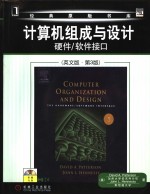

COMPUTER ORGANIZATION AND DESIGN:THE HARDWARE/SOFTWARE INTERFACE (THIRD EDITION)PDF电子书下载
- 电子书积分:18 积分如何计算积分?
- 作 者:[美]加州大学伯克利分校 斯坦福大学著
- 出 版 社:机械工业出版社
- 出版年份:2006
- ISBN:
- 页数:621 页
1Computer Abstractions and Technology 2
1.1 Introduction 3
1.2 Below Your Program 11
1.3 Under the Covers 15
1.4 Real Stuff: Manufacturing Pentium 4 Chips 28
1.5 Fallacies and Pitfalls 33
1.6 Concluding Remarks 35
1.7 Historical Perspective and Further Reading 36
1.8 Exercises 36
COMPUTERS IN THE REAL WORLD Informatlon Technology for the 4 Billion without IT 44
2 Instructions: Language of the Computer 46
2.1 Introduction 48
2.2 Operations of the Computer Hardware 49
2.3 Operands of the Computer Hardware 52
2.4 Representing Instructions in the Computer 60
2.5 Logical Operations 68
2.6 Instructions for Making Decisions 72
2.7 Supporting Procedures in Computer Hardware 79
2.8 Communicating with People 90
2.9 MIPS Addressing for 32-Bit Immediates and Addresses 95
2.10 Translating and Starting a Program 106
2.11 How Compilers Optimize 116
2.12 How Compilers Work: An Introduction 121
2.13 A C Sort Example to Put It All Together 121
2.14 Implementing an Object-Oriented Language 130
2.15 Arrays versus Pointers 130
2.16 Real Stuff: IA-32 Instructions 134
2.17 Fallacies and Pitfalls 143
2.18 Concluding Remarks 145
2.19 Historical Perspective and Further Reading 147
2.20 Exercises 147
COMPUTERS IN THE REAL WORLD Helping Save Our Environment with Data 156
3 Arithmetic for Computers 158
3.1 Introduction 160
3.2 Signed and Unsigned Numbers 160
3.3 Addition and Subtraction 170
3.4 Multiplication 176
3.5 Division 183
3.6 Floating Point 189
3.7 Real Stuff: Floating Point in the IA-32 217
3.8 Fallacies and Pitfalls 220
3.9 Concluding Remarks 225
3.10 Historical Perspective and Further Reading 229
3.11 Exercises 229
COMPUTERS IN THE REAL WORLD Reconstructing the Ancient World 236
4 Assessing and Understanding Performance 238
4.1 Introduction 240
4.2 CPU Performance and Its Factors 246
4.3 Evaluating Performance 254
4.4 Real Stuff: Two SPEC Benchmarks and the Performance of Recent Intel Processors 259
4.5 Fallacies and Pitfalls 266
4.6 Concluding Remarks 270
4.7 Historical Perspective and Further Reading 272
4.8 Exercises 272
COMPUTERS IN THE REAL WORLD Moving People Faster and More Safely 280
5 The Processor: Datapath and Control 282
5.1 Introduction 284
5.2 Logic Design Conventions 289
5.3 Building a Datapath 292
5.4 A Simple Implementation Scheme 300
5.5 A Multicycle Implementation 318
5.6 Exceptions 340
5.7 Microprogramming: Simplifying Control Design 346
5.8 An Introduction to Digital Design Using a Hardware Design Language 346
5.9 Real Stuff: The Organization of Recent Pentium Implementations 347
5.10 Fallacies and Pitfalls 350
5.11 Concluding Remarks 352
5.12 Historical Perspective and Further Reading 353
5.13 Exercises 354
COMPUTERS IN THE REAL WORLD Empowering the Dlsabled 366
6 Enhancing Performance with Pipelining 368
6.1 An Overview of Pipelining 370
6.2 A Pipelined Datapath 384
6.3 Pipelined Control 399
6.4 Data Hazards and Forwarding 402
6.5 Data Hazards and Stalls 413
6.6 Branch Hazards 416
6.7 Using a Hardware Description Language to Describe and Model a Pipeline 426
6.8 Exceptions 427
6.9 Advanced Pipelining: Extracting More Performance 432
6.10 Real Stuff: The Pentium 4 Pipeline 448
6.11 Fallacies and Pitfalls 451
6.12 Concluding Remarks 452
6.13 Historical Perspective and Further Reading 454
6.14 Exercises 454
COMPUTERS IN THE REAL WORLD Mass Communlcatlon without Gatekeepers 464
7 Large and Fast: Exploiting Memory Hierarchy 466
7.1 Introduction 468
7.2 The Basics of Caches 473
7.3 Measuring and Improving Cache Performance 492
7.4 Virtual Memory 511
7.5 A Common Framework for Memory Hierarchies 538
7.6 Real Stuff: The Pentium P4 and the AMD Opteron Memory Hierarchies 546
7.7 Fallacies and Pitfalls 550
7.8 Concluding Remarks 552
7.9 Historical Perspective and Further Reading 555
7.10 Exercises 555
COMPUTERS IN THE REAL WORLD Saving the World’s A Treasures 562
8 Storage, Networks, and Other Peripherals 564
8.1 Introduction 566
8.2 Disk Storage and Dependability 569
8.3 Networks 580
8.4 Buses and Other Connections between Processors, Memory, and I/O Devices 581
8.5 Interfacing I/O Devices to the Processor, Memory, and Operating System 588
8.6 I/O Performance Measures: Examples from Disk and File Systems 597
8.7 Designing an I/O System 600
8.8 Real Stuff: A Digital Camera 603
8.9 Fallacies and Pitfalls 606
8.10 Concluding Remarks 609
8.11 Historical Perspective and Further Reading 611
8.12 Exercises 611
COMPUTERS IN THE REAL WORLD Saving Lives through Better Dlagnosis 622
- 《大学计算机实验指导及习题解答》曹成志,宋长龙 2019
- 《大学生心理健康与人生发展》王琳责任编辑;(中国)肖宇 2019
- 《大学英语四级考试全真试题 标准模拟 四级》汪开虎主编 2012
- 《大学英语教学的跨文化交际视角研究与创新发展》许丽云,刘枫,尚利明著 2020
- 《复旦大学新闻学院教授学术丛书 新闻实务随想录》刘海贵 2019
- 《大学英语综合教程 1》王佃春,骆敏主编 2015
- 《大学物理简明教程 下 第2版》施卫主编 2020
- 《大学化学实验》李爱勤,侯学会主编 2016
- 《中国综合性大学法语学科表征研究》田园著 2019
- 《高等院校教材 新时代大学英语阅读教程 1》(中国)傅超波 2019
- 《SQL与关系数据库理论》(美)戴特(C.J.Date) 2019
- 《魔法销售台词》(美)埃尔默·惠勒著 2019
- 《看漫画学钢琴 技巧 3》高宁译;(日)川崎美雪 2019
- 《优势谈判 15周年经典版》(美)罗杰·道森 2018
- 《社会学与人类生活 社会问题解析 第11版》(美)James M. Henslin(詹姆斯·M. 汉斯林) 2019
- 《海明威书信集:1917-1961 下》(美)海明威(Ernest Hemingway)著;潘小松译 2019
- 《迁徙 默温自选诗集 上》(美)W.S.默温著;伽禾译 2020
- 《上帝的孤独者 下 托马斯·沃尔夫短篇小说集》(美)托马斯·沃尔夫著;刘积源译 2017
- 《巴黎永远没个完》(美)海明威著 2017
- 《剑桥国际英语写作教程 段落写作》(美)吉尔·辛格尔顿(Jill Shingleton)编著 2019
- 《高等教育双机械基础课程系列教材 高等学校教材 机械设计课程设计手册 第5版》吴宗泽,罗圣国,高志,李威 2018
- 《中国十大出版家》王震,贺越明著 1991
- 《近代民营出版机构的英语函授教育 以“商务、中华、开明”函授学校为个案 1915年-1946年版》丁伟 2017
- 《新工业时代 世界级工业家张毓强和他的“新石头记”》秦朔 2019
- 《智能制造高技能人才培养规划丛书 ABB工业机器人虚拟仿真教程》(中国)工控帮教研组 2019
- 《AutoCAD机械设计实例精解 2019中文版》北京兆迪科技有限公司编著 2019
- 《陶瓷工业节能减排技术丛书 陶瓷工业节能减排与污染综合治理》罗民华著 2017
- 《全国职业院校工业机器人技术专业规划教材 工业机器人现场编程》(中国)项万明 2019
- 《国之重器出版工程 云化虚拟现实技术与应用》熊华平 2019
- 《新闻出版博物馆 总第33期》新闻出版博物馆 2018
